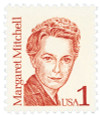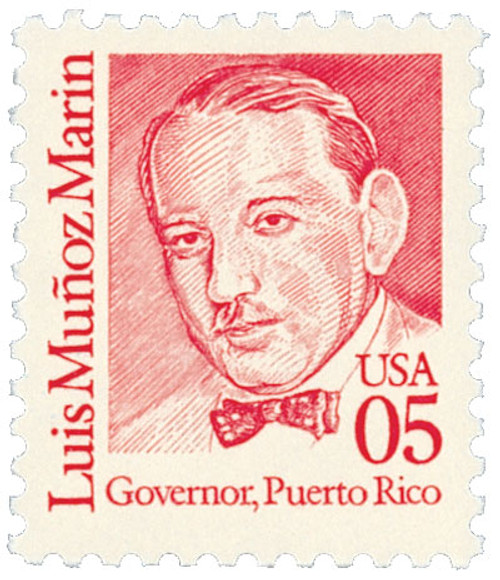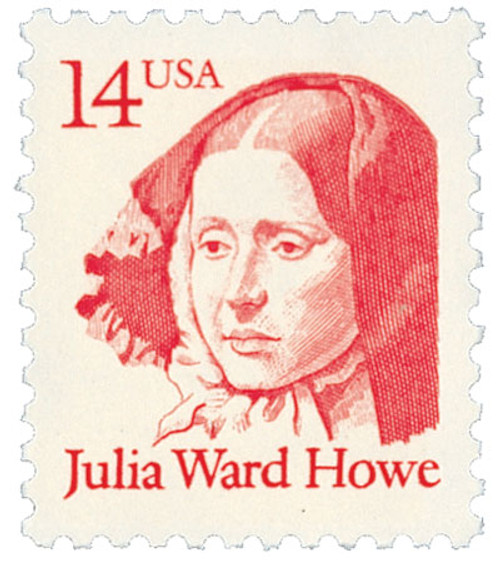
# 2168 - 1986 1c Great Americans: Margaret Mitchell
U.S. #2168
1986 1¢ Margaret Mitchell
Great Americans
- 31st stamp in Great Americans Series
- Issued exactly 50 years after her book, Gone with the Wind, first went on sale
- Mitchell was the eight female writer honored on a US stamp
Stamp Category: Definitive
Series: Great Americans
Value: 1¢, used for additional postage when rate-change occurs
First Day of Issue: June 30, 1986
First Day City: Atlanta, Georgia
Quantity Issued: 56,950,000
Printed by: Bureau of Engraving and Printing
Printing Method: Engraved
Format: Panes of 100
Perforations: 11
Color: Brownish vermilion
Why the stamp was issued: This stamp replaced the 1¢ Dorothea Dix. It’s what the USPS calls “change maker” postage. These stamps with denominations of 1¢ through 6¢ are produced to make up the wide variety of rates for third-class parcel post, which has many combinations of charges for weight and distance. These stamps were also useful when first-class rates went up, before the USPS could release stamps at the new rate.
About the stamp design: Ron Adiar created the artwork for this stamp based on a photo of Mitchell that appeared on the cover of Gone with the Wind letters 1936-1949.
First Day City: The First Day ceremony for this stamp was held at the Omni International complex in Atlanta, Georgia. It was part of an eight-day celebration marking the 50th anniversary of Gone with the Wind.
About the Great Americans Series: The Great Americans Series was created to replace the Americana Series. The new series would be characterized by a standard definitive size, simple design, and monochromatic colors.
This simple design included a portrait, “USA,” the denomination, the person’s name, and in some cases, their occupation or reason for recognition. The first stamp in the new series was issued on December 27, 1980. It honored Sequoyah and fulfilled the new international postcard rate that would go into effect in January 1981.
The Great Americans Series would honor a wider range of people than the previous Prominent Americans and Liberty Series. While those series mainly honored presidents and politicians, the Great Americans Series featured people from many fields and ethnicities. They were individuals who were leaders in education, the military, literature, the arts, and human and civil rights. Plus, while the previous series only honored a few women, the Great Americans featured 15 women. This was also the first definitive series to honor Native Americans, with five stamps.
The Bureau of Engraving and Printing (BEP) produced most of the stamps, but private firms printed some. Several stamps saw multiple printings. The result was many different varieties, with tagging being the key to understanding them. Though there were also differences in perforations, gum, paper, and ink color.
The final stamp in the series was issued on July 17, 1999, honoring Justin S. Morrill. Spanning 20 years, the Great Americans was the longest-running US definitive series. It was also the largest series of face-different stamps, with a total of 63.
Click here for all the individual stamps and click here for the complete series.
History the stamp represents: Margaret Munnerlyn Mitchell was born on November 8, 1900, in Atlanta, Georgia.
Mitchell was born into a wealthy and prominent Georgia family. When she was three, her dress caught on fire on an iron grate. After this, her mother dressed her in boys clothes and she was nicknamed Jimmy until she was 14.
Mitchell’s older relatives, which included several former Confederate soldiers, filled her childhood with first-hand accounts of the Civil War and Reconstruction. Although the tales were rich in historical detail, Mitchell was ten years old before she learned that the Confederacy had lost the war. These details – and many elements of Mitchell’s personal life – would be incorporated into her blockbuster novel, Gone With The Wind.
Mitchell was an avid reader as a child and quickly became a storyteller in her own right. She wrote stories about animals, fairy tales, and eventually adventure stories. Mitchell even designed covers for her stories and included drawings to go along with them. When she was 11, Mitchell named her publishing operation, “Urchin Publishing Co.” Over time, the young Mitchell also wrote stories of romance and honor as well as stories set in foreign locations.
As a teenager, Mitchell attended a private girls school where she was very active in the drama club. She played the male characters in a few Shakespeare plays and also wrote and performed in her own plays. Mitchell also joined the school’s literary club and had two stories published in the yearbook. Her English teacher recognized her writing talent and encouraged her to continue to work at it.
Mitchell’s mother was a vocal suffragist and president of the Atlanta Woman’s Suffrage League. She even took Margaret to suffrage rallies led by Carrie Chapman Catt. Reminiscent of her character Scarlett O’Hara’s life, Mitchell lost her mother in the great influenza pandemic of 1918. Mitchell left Smith College after a year, and returned home to run her father’s household.
In 1922, Mitchell briefly married bootlegger Red Upshaw. Some film buffs claim Upshaw was the model for Rhett Butler while others believe it was Mitchell’s famous cousin, John “Doc” Holliday. Mitchell later married John Marsh, a former suitor who had been the best man at her first wedding.
During her first marriage, Mitchell started writing articles for The Atlanta Journal Sunday Magazine. She had no prior journalism experience and got no encouragement from her family. Her stories were vivid and interesting, however. She only worked for the paper for about four years, quitting after she suffered an ankle injury that didn’t heal properly. Overall, she wrote 129 feature articles, 85 news stories, and a number of book reviews.
While at home recuperating from her injured ankle, Mitchell had initially tasked her husband with bringing her home large numbers of books from the library. Eventually he said, “can’t you write a book instead of reading thousands of them?” This led her to begin working on her Civil War-era novel, Gone With the Wind. Chapters of the book were written out of sequence over a period of years and hidden in envelopes under beds, tables, and in closets.
Although Mitchell described her work as “lousy,” she received a record $50,000 for the film rights and the movie received a record-breaking number of Academy Awards. Gone With the Wind was the only novel Mitchell published during her lifetime and it was awarded the National Book Award for Most Distinguished Novel of 1936. She was also awarded the Pulitzer Prize for Fiction in 1937. Gone With the Wind is one of the most widely read novels in history. It has been translated into 27 languages and published in 327 countries.
During World War II, Mitchell volunteered with the Red Cross and raised money selling war bonds. She also helped sew hospital gowns and patch uniforms. Mitchell spent a good deal of time writing heartfelt letters to soldiers serving overseas. Additionally, Mitchell sponsored two light cruisers during the war, both of which were named the USS Atlanta.
In 1949, Mitchell was struck by a speeding drunk driver and died five days later, on August 16. Several of her writings were later published after her death, including a novella called Lost Laysen.
U.S. #2168
1986 1¢ Margaret Mitchell
Great Americans
- 31st stamp in Great Americans Series
- Issued exactly 50 years after her book, Gone with the Wind, first went on sale
- Mitchell was the eight female writer honored on a US stamp
Stamp Category: Definitive
Series: Great Americans
Value: 1¢, used for additional postage when rate-change occurs
First Day of Issue: June 30, 1986
First Day City: Atlanta, Georgia
Quantity Issued: 56,950,000
Printed by: Bureau of Engraving and Printing
Printing Method: Engraved
Format: Panes of 100
Perforations: 11
Color: Brownish vermilion
Why the stamp was issued: This stamp replaced the 1¢ Dorothea Dix. It’s what the USPS calls “change maker” postage. These stamps with denominations of 1¢ through 6¢ are produced to make up the wide variety of rates for third-class parcel post, which has many combinations of charges for weight and distance. These stamps were also useful when first-class rates went up, before the USPS could release stamps at the new rate.
About the stamp design: Ron Adiar created the artwork for this stamp based on a photo of Mitchell that appeared on the cover of Gone with the Wind letters 1936-1949.
First Day City: The First Day ceremony for this stamp was held at the Omni International complex in Atlanta, Georgia. It was part of an eight-day celebration marking the 50th anniversary of Gone with the Wind.
About the Great Americans Series: The Great Americans Series was created to replace the Americana Series. The new series would be characterized by a standard definitive size, simple design, and monochromatic colors.
This simple design included a portrait, “USA,” the denomination, the person’s name, and in some cases, their occupation or reason for recognition. The first stamp in the new series was issued on December 27, 1980. It honored Sequoyah and fulfilled the new international postcard rate that would go into effect in January 1981.
The Great Americans Series would honor a wider range of people than the previous Prominent Americans and Liberty Series. While those series mainly honored presidents and politicians, the Great Americans Series featured people from many fields and ethnicities. They were individuals who were leaders in education, the military, literature, the arts, and human and civil rights. Plus, while the previous series only honored a few women, the Great Americans featured 15 women. This was also the first definitive series to honor Native Americans, with five stamps.
The Bureau of Engraving and Printing (BEP) produced most of the stamps, but private firms printed some. Several stamps saw multiple printings. The result was many different varieties, with tagging being the key to understanding them. Though there were also differences in perforations, gum, paper, and ink color.
The final stamp in the series was issued on July 17, 1999, honoring Justin S. Morrill. Spanning 20 years, the Great Americans was the longest-running US definitive series. It was also the largest series of face-different stamps, with a total of 63.
Click here for all the individual stamps and click here for the complete series.
History the stamp represents: Margaret Munnerlyn Mitchell was born on November 8, 1900, in Atlanta, Georgia.
Mitchell was born into a wealthy and prominent Georgia family. When she was three, her dress caught on fire on an iron grate. After this, her mother dressed her in boys clothes and she was nicknamed Jimmy until she was 14.
Mitchell’s older relatives, which included several former Confederate soldiers, filled her childhood with first-hand accounts of the Civil War and Reconstruction. Although the tales were rich in historical detail, Mitchell was ten years old before she learned that the Confederacy had lost the war. These details – and many elements of Mitchell’s personal life – would be incorporated into her blockbuster novel, Gone With The Wind.
Mitchell was an avid reader as a child and quickly became a storyteller in her own right. She wrote stories about animals, fairy tales, and eventually adventure stories. Mitchell even designed covers for her stories and included drawings to go along with them. When she was 11, Mitchell named her publishing operation, “Urchin Publishing Co.” Over time, the young Mitchell also wrote stories of romance and honor as well as stories set in foreign locations.
As a teenager, Mitchell attended a private girls school where she was very active in the drama club. She played the male characters in a few Shakespeare plays and also wrote and performed in her own plays. Mitchell also joined the school’s literary club and had two stories published in the yearbook. Her English teacher recognized her writing talent and encouraged her to continue to work at it.
Mitchell’s mother was a vocal suffragist and president of the Atlanta Woman’s Suffrage League. She even took Margaret to suffrage rallies led by Carrie Chapman Catt. Reminiscent of her character Scarlett O’Hara’s life, Mitchell lost her mother in the great influenza pandemic of 1918. Mitchell left Smith College after a year, and returned home to run her father’s household.
In 1922, Mitchell briefly married bootlegger Red Upshaw. Some film buffs claim Upshaw was the model for Rhett Butler while others believe it was Mitchell’s famous cousin, John “Doc” Holliday. Mitchell later married John Marsh, a former suitor who had been the best man at her first wedding.
During her first marriage, Mitchell started writing articles for The Atlanta Journal Sunday Magazine. She had no prior journalism experience and got no encouragement from her family. Her stories were vivid and interesting, however. She only worked for the paper for about four years, quitting after she suffered an ankle injury that didn’t heal properly. Overall, she wrote 129 feature articles, 85 news stories, and a number of book reviews.
While at home recuperating from her injured ankle, Mitchell had initially tasked her husband with bringing her home large numbers of books from the library. Eventually he said, “can’t you write a book instead of reading thousands of them?” This led her to begin working on her Civil War-era novel, Gone With the Wind. Chapters of the book were written out of sequence over a period of years and hidden in envelopes under beds, tables, and in closets.
Although Mitchell described her work as “lousy,” she received a record $50,000 for the film rights and the movie received a record-breaking number of Academy Awards. Gone With the Wind was the only novel Mitchell published during her lifetime and it was awarded the National Book Award for Most Distinguished Novel of 1936. She was also awarded the Pulitzer Prize for Fiction in 1937. Gone With the Wind is one of the most widely read novels in history. It has been translated into 27 languages and published in 327 countries.
During World War II, Mitchell volunteered with the Red Cross and raised money selling war bonds. She also helped sew hospital gowns and patch uniforms. Mitchell spent a good deal of time writing heartfelt letters to soldiers serving overseas. Additionally, Mitchell sponsored two light cruisers during the war, both of which were named the USS Atlanta.
In 1949, Mitchell was struck by a speeding drunk driver and died five days later, on August 16. Several of her writings were later published after her death, including a novella called Lost Laysen.




















